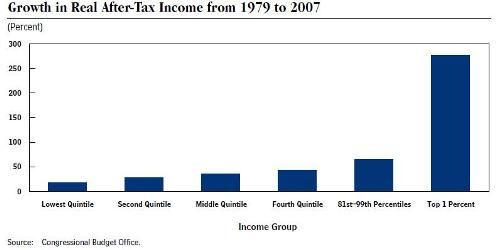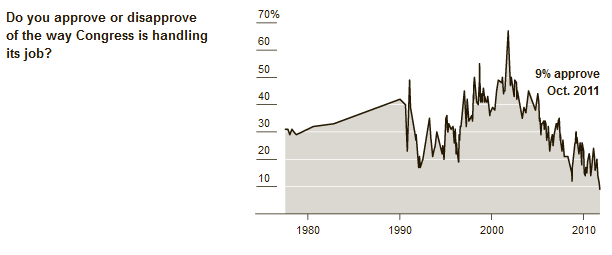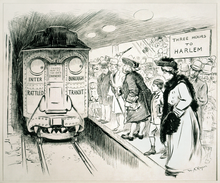Banking and Politics: On a Razor’s Edge
By Mike Lux, Crooks and Liars
October 27, 2011 11:00 AM
This is a do-over moment for the President. Ron Suskind’s book, “Confidence Men,” made clear: Obama wanted to do the right thing on the big banks in 2009. He wanted us to choose the path Sweden chose to get back to economic health in the 1990s -rather than the one that led to Japan’s lost decade - a path that involved directly taking on the big banks. He wanted to take over Citibank and send it to resolution authority. But Rahm Emanuel, Larry Summers and Geithner didn’t follow his orders, slow-walked things until they weren’t relevant anymore, and gave us the policies that are potentially sending us to our own lost decade. These missed policy chances gave us a terribly weakened economy, and gave the public the perception the President was soft on Wall Street. Obama now has a chance to get this economy back on the road to a real recovery, and to simultaneously show that he will stand up the Wall Street tycoons.
When Dodd-Frank was passed, we were promised there would be no more bank bailouts, and that our government was once again capable of doing what needs to be done in terms of bringing the Wall Street tycoons who wrecked our economy to heel. Now is the moment to prove that right. Start by putting the zombie bank Bank of America in receivership where they belong – the Dodd-Frank bill gives us the resolution authority to get that done. Next, drop efforts to give bankers immunity for the million-plus counts of perjury and fraud they have likely committed with the robo-signing and other foreclosure-related scandals, and force them to the table so they will finally write down the mortgage debt on all these underwater mortgages. Finally, get DOJ involved in helping to investigate fraudulent banking practices, and get the anti-trust division involved too, because unless these banks start to get broken up, our financial marketplace will continue to be badly warped by their overwhelming market power.
…
These are huge steps, but the Obama administration has the ability to do them. If the 2008 crisis proved nothing else, it is that our government in a financial crisis has the ability to do whatever needs to be done in a crisis. There’s a story that when Bear Stearns was being forced by Hank Paulson to merge with Morgan in 2008, that the Bear Stearns board was balking at the incredibly low price they would be getting on their shares of stock. Paulson calmly informed them he had brought a team of FBI agents with them, that if the merger was not agreed to he would be seizing every computer in the building and the FBI would start combing through the books and emails to see what illegal acts were committed. The Bear Stearns board immediately voted to go forward with the merger. The management of these huge banks on Wall Street know they have been blatantly violating all kinds of laws for a long time, which is why they are so eager to do a quick settlement with the state AGs and the feds for legal immunity. The administration has the tools, both legal and regulatory, to force them to the table and get things done. But they need to step up and make it happen. Given the deep and overwhelming problems in the financial and housing sectors, doing big things is the only way to get the economy back on track.
And they all lived in fairy-tale land happily ever after.
Or…
Not so much.






 Late last night, Scott Olsen, a former Marine, two-time Iraq war veteran, and member of Iraq Veterans Against the War, sustained a skull fracture after being shot in the head with a police projectile while peacefully participating in an Occupy Oakland march. The march began at a downtown library and headed towards City Hall in an effort to reclaim a site-recently cleared by police-that had previously served as an encampment for members of the 99% movement.
Late last night, Scott Olsen, a former Marine, two-time Iraq war veteran, and member of Iraq Veterans Against the War, sustained a skull fracture after being shot in the head with a police projectile while peacefully participating in an Occupy Oakland march. The march began at a downtown library and headed towards City Hall in an effort to reclaim a site-recently cleared by police-that had previously served as an encampment for members of the 99% movement. While London boasts the world’s oldest underground train network (opened in 1863) and Boston built the first subway in the United States in 1897, the New York City subway soon became the largest American system. The first line, operated by the Interborough Rapid Transit Company (IRT), traveled 9.1 miles through 28 stations. Running from City Hall in lower Manhattan to Grand Central Terminal in midtown, and then heading west along 42nd Street to Times Square, the line finished by zipping north, all the way to 145th Street and Broadway in Harlem. On opening day, Mayor McClellan so enjoyed his stint as engineer that he stayed at the controls all the way from City Hall to 103rd Street.
While London boasts the world’s oldest underground train network (opened in 1863) and Boston built the first subway in the United States in 1897, the New York City subway soon became the largest American system. The first line, operated by the Interborough Rapid Transit Company (IRT), traveled 9.1 miles through 28 stations. Running from City Hall in lower Manhattan to Grand Central Terminal in midtown, and then heading west along 42nd Street to Times Square, the line finished by zipping north, all the way to 145th Street and Broadway in Harlem. On opening day, Mayor McClellan so enjoyed his stint as engineer that he stayed at the controls all the way from City Hall to 103rd Street.
Recent Comments